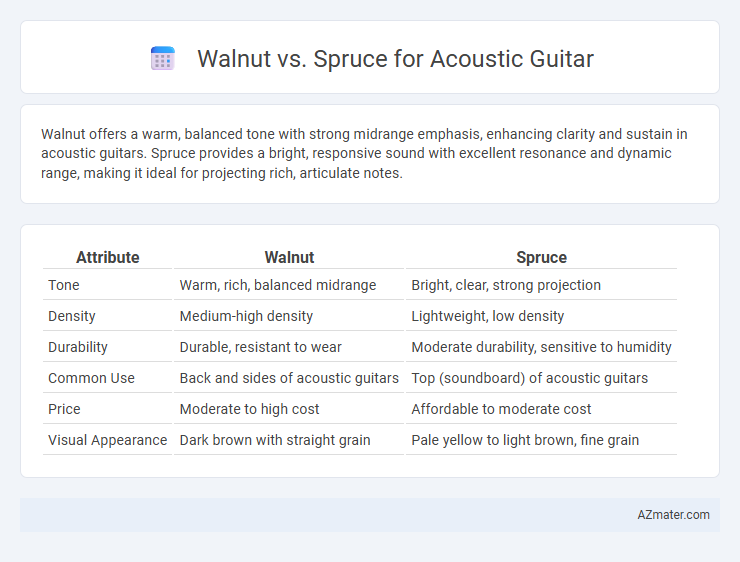Walnut offers a warm, balanced tone with strong midrange emphasis, enhancing clarity and sustain in acoustic guitars. Spruce provides a bright, responsive sound with excellent resonance and dynamic range, making it ideal for projecting rich, articulate notes.
Table of Comparison
| Attribute | Walnut | Spruce |
|---|---|---|
| Tone | Warm, rich, balanced midrange | Bright, clear, strong projection |
| Density | Medium-high density | Lightweight, low density |
| Durability | Durable, resistant to wear | Moderate durability, sensitive to humidity |
| Common Use | Back and sides of acoustic guitars | Top (soundboard) of acoustic guitars |
| Price | Moderate to high cost | Affordable to moderate cost |
| Visual Appearance | Dark brown with straight grain | Pale yellow to light brown, fine grain |
Overview: Walnut vs Spruce for Acoustic Guitars
Walnut offers a warm, balanced tone with rich midrange frequencies and clear highs, making it ideal for players seeking a smooth, versatile sound. Spruce, especially Sitka spruce, is renowned for its bright, dynamic response and strong projection, providing a crisp, articulate sound favored in many acoustic guitars. While walnut tends to deliver a warmer, softer resonance, spruce excels in clarity and volume, making each wood choice suitable for different playing styles and tonal preferences.
Visual Differences Between Walnut and Spruce
Walnut exhibits a rich, dark brown color with striking grain patterns ranging from straight to wavy, offering an elegant, warm visual appeal on acoustic guitars. Spruce, in contrast, displays a light, creamy to pale yellow tone with subtle, straight grain lines that contribute to a clean, classic appearance. The contrast between walnut's bold, textured look and spruce's smooth, uniform surface significantly influences the guitar's aesthetic identity.
Tonewood Characteristics: Walnut Explained
Walnut is a dense, hardwood tonewood known for its balanced and warm tonal qualities, combining bright trebles with rich midrange and a smooth, controlled bass response. Its natural resonance enhances articulation and clarity, making it a popular choice for acoustic guitar backs and sides that deliver both depth and definition. Compared to spruce, walnut offers a slightly darker, more complex sound with strong projection and sustain, appealing to players seeking warmth without sacrificing brightness.
Spruce Top: Properties and Benefits
Spruce tops are highly valued in acoustic guitars for their exceptional strength-to-weight ratio, which provides a bright, clear, and resonant tone with excellent dynamic range. This wood's stiffness allows for strong projection and responsiveness, making it ideal for various playing styles, from fingerpicking to strumming. The open grain structure of spruce enhances soundboard vibration, delivering crisp highs and balanced midrange frequencies that contribute to a versatile and articulate sound profile.
Sound Profile Comparison: Walnut vs Spruce
Walnut offers a warm, balanced sound with rich midrange tones and a smooth low end, creating a full-bodied resonance ideal for fingerpicking styles. Spruce provides a bright, clear tone with strong projection and excellent dynamic range, making it suitable for strumming and versatile playing. The difference in sound profiles makes walnut better for warmth and complexity, while spruce excels in clarity and volume.
Durability and Longevity of Each Wood
Walnut offers excellent durability with a dense grain structure that resists wear and impact, making it a long-lasting choice for acoustic guitars. Spruce, known primarily for its tonal qualities, is softer and more prone to dents and scratches, which can affect its longevity without proper care. Over time, walnut guitars tend to maintain structural integrity better, while spruce requires more maintenance to preserve its acoustic performance and physical condition.
Playability: How Each Wood Affects Performance
Walnut wood offers a balanced feel with moderate density, providing smooth playability and quick response, making it ideal for fingerstyle and complex chord work. Spruce, known for its lightweight and stiff characteristics, enhances string articulation and dynamic range, allowing for easier note separation and faster attack. The choice between walnut and spruce significantly impacts guitar performance by influencing tone clarity and player comfort during extended sessions.
Price and Availability Differences
Walnut acoustic guitars typically cost more than spruce models due to the rarity and density of walnut wood, which provides a warmer tone and enhanced durability. Spruce is widely available and more affordable, making it the standard choice for entry-level and mid-range acoustic guitars. The higher price and limited availability of walnut guitars often appeal to experienced players seeking unique tonal qualities and aesthetics.
Best Use Cases for Walnut and Spruce Guitars
Walnut guitars excel in delivering a warm, balanced tone with rich midrange frequencies, making them ideal for fingerstyle and blues players who require clarity and depth. Spruce tops provide a bright, dynamic sound with excellent projection and responsiveness, preferred by strummers and flatpickers in genres like folk and bluegrass. Walnut is favored for its durability and aesthetic appeal in mid-range guitars, while spruce remains the go-to choice for professional performers seeking versatile tonal range and articulation.
Choosing the Right Wood for Your Playing Style
Walnut offers a warm, balanced tone with strong midrange frequencies, making it ideal for fingerstyle players seeking clarity and definition. Spruce provides a bright, articulate sound with excellent projection, preferred by strummers and flatpickers who require dynamic responsiveness. Selecting walnut enhances softer, nuanced playing, while spruce suits aggressive, energetic styles demanding volume and sustain.

Infographic: Walnut vs Spruce for Acoustic Guitar
 azmater.com
azmater.com